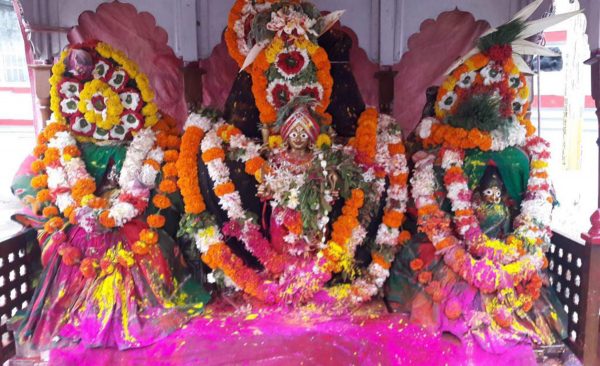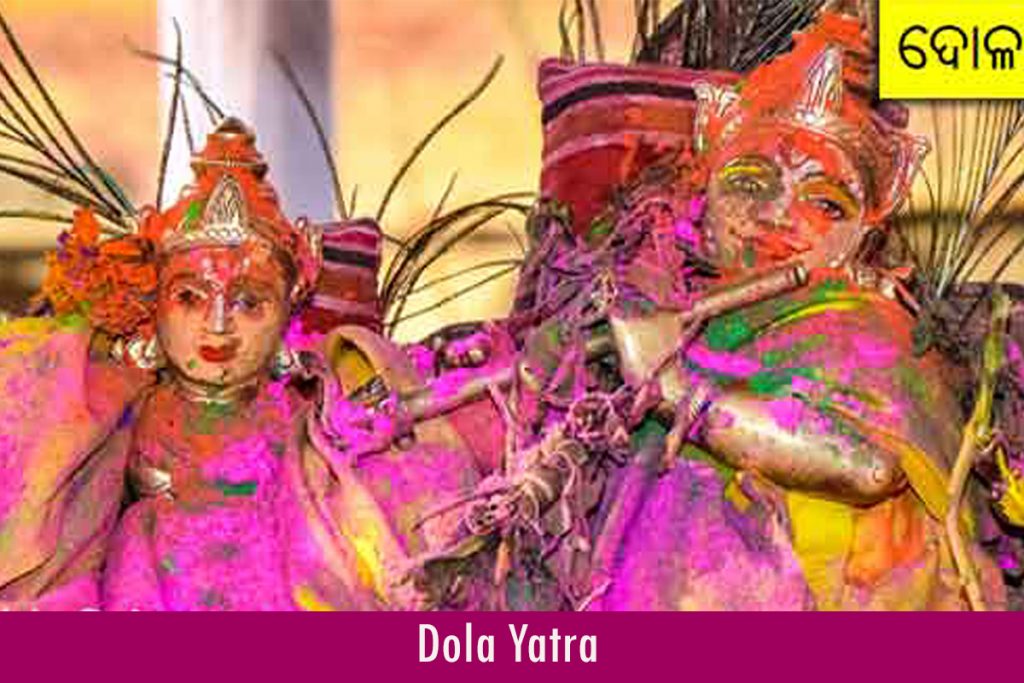
In Odisha, the Dol Yatra starts from Faghu Dashmi. Its importance is closely related to the propagation and dissemination of the Vaishnava religion. It is celebrated as a festival of affection, kindness, and traditional friendship, especially among the villages, among the groups, among the individuals. It is considered to be a pilgrimage to welcome the mighty Rituraj Basanta in the power of awakening new vibrations to the earth. Various descriptions of Dolayatra in the collection of Satananda collected by the twelfth-century Oriya astronomer Satananda clearly suggest that Dolayatra has been celebrated in Odisha for at least eight hundred years. The pilgrimage is usually celebrated for five days and is called Rajdol or Panchudol. In some places, the full moon day of the month of Falgun begins with a five-day procession, while in others, the full moon day is called the last day of the festival, the end of the festival. In some places where the festival is celebrated from the full moon day to the sixth day, it is called the new wave and where it can be celebrated for nine days, it is called the new wave. There are also examples of a seven-day and ten-day procession in many places.
Various myths are associated with Dol. Radha-Krishna, on the one hand, is the epitome of the love story, and on the other hand, the story of other myths. Both the colorful game and the glittering fire of Holika Dahan combine the festivities with the victory of the auspicious symbol over the evil forces. Sriradha – All other legendary anecdotes related to Sri Krishna’s love affair, dol and color are associated with this Dol-Holi twinning day. According to some, the death was due to the death of the mighty monster Mardhasur, who reduced the number of sins from the earth. On the one hand, Nab Basanta, Kokil’s Kuhutan, Nab Mukul on the Chutbhai tree, Mildumanda Shital Samiran and on the other hand, after the untimely death of Sati, Rudra is concentrated in the form of the great Mahadev Shiva So the fear, the satiety, and the high expectations of the Goddess Tarakasur are oppressive – a good omen. Karthikeya’s birth is possible only if Mahadev Shiva is united with Parvati, the infinitely beautiful Himavanta daughter Parvati, only if the attention of Mahayogi Shiva is distracted. It is Karthikeya who is the only one capable of killing the stars by killing the star god and giving fear to the gods.
One by one, the five gods fired Madan, the unseen eye of Shiva. The third eye was burned in the forehead. The goddess Madan was burnt to ashes in an instant. The goddess appeared, weeping loudly. Madan, on the self-immolation of his own body, but that day went on to achieve a desired goal through the Mahadev for the protection of the gods. Some say that the divine burning of Holi is an image of burning this limb in the fire. The tradition of burning fires during the Nada Gadakari (Aighara / Agira) Dol full moon night or Holi festival is associated with the mythological anecdote of Bhakta Prahlad. The story is known as Holika Dahan. Holika is a monster and her burning king Hiranyakashipur is celebrated as a symbolic victory of the divine power that blesses the devotee and the child Prahlad over the evil forces inspired by atheism. According to mythology, Holika was the sister of Hiranyakashipur – a bridegroom who received a gift from Shiva that he would not drown or burn. The Holika monster was set on fire with his son Prahlad to teach the atheist Hiranyakashipu in the love of Lord Vishnu, in which the baby boy was rescued while Holika was burnt to death.
In some areas, the story of Krishna’s efforts is linked to the Holi festival by the entry and breastfeeding of the pseudo-heroine Putana from Gopura from Mathura. Some have linked the fire to the demon’s death and his funeral. When Asuraraja Kansa heard the news that his real killer was growing up in Gopapur, he wanted to kill all the children of Gopapur in some way. That is why the demon-possessed Putana was sent to Gopapur to fill the breasts with halal poison and drink it as milk to save the lives of all the Gopal children. Krishna deceived Putana into breastfeeding and seduced the deceitful beauty. Putana, who took on the divine form of beauty, died revealing her true form. Many are of the opinion that Holi or Dola Utsav is celebrated because Lord Krishna forbade the saints to observe. However, the festival is also associated with the death of some other Kansa-inspired asuras, Asurini, from Gopalila in Srimad Bhagavatam. But one of the best scenes of Gopalila’s legendary Radhakrishna duo reunion is Radhakrishna’s doli in the doli or the duo idol in the hanging.
According to the Oriya calendar, the full moon date of the month of Falgun is called Dol Purnima. The pilgrimage usually begins on the tenth day of Falgun Shukla. The main deities of the festival are Thakur Radha and Krishna. Radhakrishna’s sculptures are taken in small planes to the gates of almost every village in a grand manner. At almost every door, offerings are made to the Thakurs, as well as to the Dakshina. The offerings offered at each door for the sake of Thakur are called Dwari Bhogs. On Dolapurnami, the Thakurs are usually taken to a pavilion built on the southeast side of the temple. The name of that mandapa is Dol mandapa. At the same time, the Thakurs play doli and offer red abir there.
Enthusiasm for the pilgrimage from Purapalli Faghu Dashmi across Odisha is on the rise. In the village, the procession begins at the Radhakrishna Temple or at the Shree Gannath Temple with a moving idol or a plane, and the Thakurs enjoy the procession by going door to door. It has become such a mass festival that in some villages near Khordha – in Gadbani, Manikgoda – where the Muslims were appointed by the Dalbehera king or later converted to the Hindu Dalbehera by the Muslims – the Lord also feeds them at the door. Similarly, the Vaishnava devotees along with the Shaiva Peetha and the Dol Mela and the Dol Mandapa help to increase the friendship of the Peetha. Dol melan is usually held at or near Shaiva, Shakta or other undisputed seats. Radhakrishna’s plane, which travels around the village from midnight to midnight, arrives and stays there for five nights. The festival has unique traditions, heritage and naming in different parts of Odisha.
There are three main types of swings
Falgun’s Rajdol Melan, i.e. Faghu (Shuklapaksha) from Dashmi to Fagun Purnima.
Panchudol Mela, five days from the full moon of Fagun to the fifth month of Chaitram Krishna.
The ten-day, ten-day melan, i.e. from the full moon of Fagun to the ninth of Chaitra Krishna.
In fact, this Rajdol festival means that all the Vaishnava peethas from Fagudashami hang in the doli in the hanging mandapa or the Sri Radhakrishna couple in a decorated plane.
Like many festivals in Odisha, Dol Chacheri and Melan are a significant combination of both travel and local gatherings. It is considered a great festival of chanting, chanting, and clapping as Shri Chaitanya Jayanti. However, because of the incompatibility between Sri Krishna and Shri Gannath, the idols of Jagannath are adorned in place of some of the hanging mandapas or peethas. Although Narayan, Vishnu, Basudev, and Krishna are mentioned in many ancient scriptures, Krishna’s life story is mainly popular in India through the Mahabharata and the Akhil Haribhansh Purana. Of these, Srimad Bhagavata is the most popular in Sanskrit, written by Byasdev and narrated by Shukmuni. In the Oriya language, it is very popular in Odisha under the auspices of the great Jagannath Das. Most importantly, the topic and topic of Srimad Bhagwat, which is not secondary or not written at all, have also gained popularity. With the exception of the Rath Yatra and the Devaswana Purnima, Dolayatra is a prominent festival of the Purimandir. Of all the references to Shri Gannath’s various pilgrimages, the importance of the pilgrimage has been acknowledged. There is a saying and belief that Dol Gobind, who was under the pressure of the Chandan Yatra in Dola, and the dwarf on the chariot during the Rath Yatra, would no longer be reborn. It is described in the spring in Sri Gita Govinda, one of the most famous works of Vaishnavism. Jagannath is worshiped under different names in different months. Of these, his name is Govinda in the month of Falgun and hence the date of Falgun Shuklapaksha Dwadashi is better known as Govind Dwadashi. The Tarkshya (Garuda) Purana describes the glory of this Govinda Dwadashitithi. On the day of Fagudashami, Govinda’s journey and village procession begins in Fagukhel and Dola. Madanmohan and Lakshmi BJ at Dolabedi. Its importance is especially recognized in almost all the villages of Odisha, especially the Brahmins.
At Shrikshetra Puri, Shri Gannath celebrates the Dolayatra in a Vaishnava manner as a folk tradition. It is known as Chacheri Leela. The word chacheri comes from the Sanskrit church. This Sanskrit word means happiness. The church is celebrated all over Odisha at the Vishnu and Krishna temples. During the festival, Dolgobind, Lakshmi and Saraswati fly to the Shree Gannath Ballabh Udyan every evening on the Fagudashami Dolabiman. The excitement and excitement of the people creates a full-fledged scene as the lion gate crosses the temple gates and crosses the Arun pillar. The wave arrives at the altar and begins to erupt. Dolgobind BJs in the guise of flowers and fragrant flowers like the Kundapus and in the guise of the red. After worship and enjoyment, Thakur comes to the temple. The coronation of the fourth deity is also held on this occasion. This is called Rajarajeshwar Besh. According to many, the longevity of Sri Chaitanya (1486 AD – 1533 AD) and the unification of Shri Gannatha as Vrindavan Bihari was the main time for the entry of Vaishnava judgments and practices into the Shri Gannatha temple. But it turns out that the saints had long tried to see Lord Krishna and Shri Gannatha together. Before 1560, a dolmandapa was built on the southeast side of the main temple within the temple enclosure, and the idol of Jagannath was taken there to celebrate the procession, but when the Thakurs were playing the doli, one side of the doli suddenly collapsed. And since the accident, the idol of Madanmohan, made of brass, has been in place as a representative of the Lord of the Chakadola world since the accident, as the idols are likely to be ruined due to the Fagukhela. Since then, the site of the mandapa has also been relocated to the north-east corner of the temple.
The Dolamandapa of Odisha refers to the Toranakriti as a high assembly. All the villages in Odisha have recognized the toran gate of the Mukteswar temple, one of the oldest and most famous temples in Odisha, as a form of this toran and dolmandapara.There are certainly no religious rules or regulations for the construction of this magnificent arch at the Siddheshwar, Mukteswar temple near Kedargauri in Bhubaneswar, but this unique example of Odisha architecture has made the unique architecture of Odisha popular in rural areas. Gold ornaments and necklaces are also made according to the Mukteswar arches.
Comments
comments
